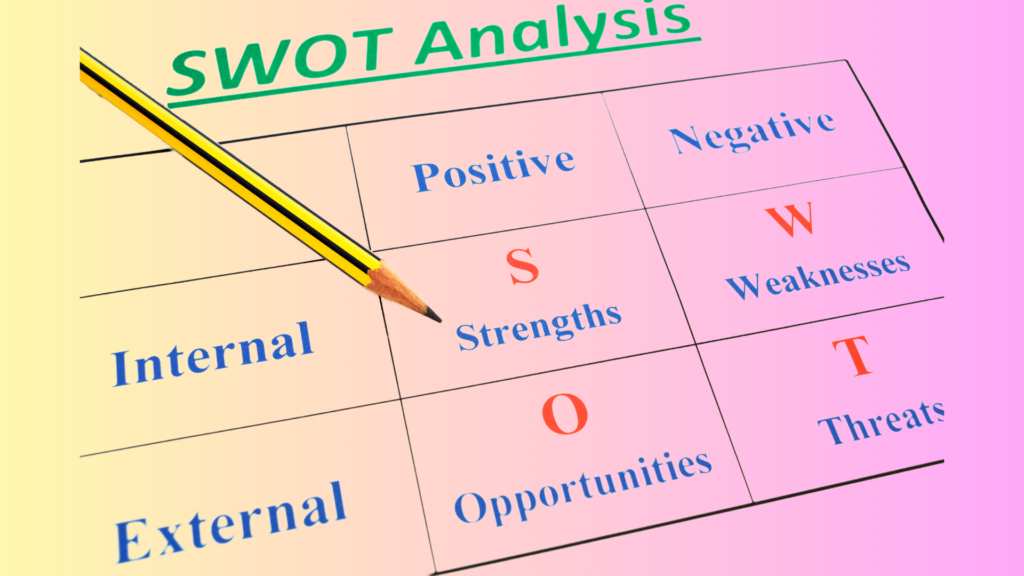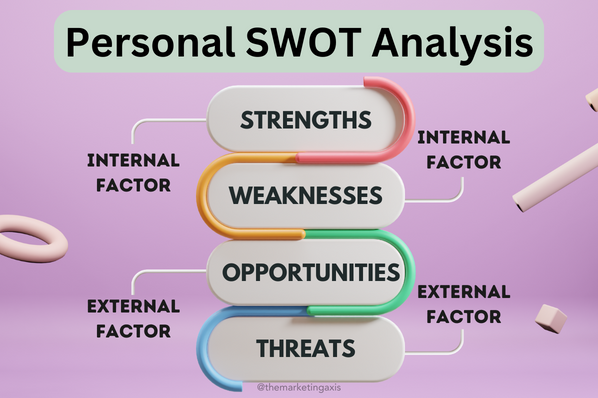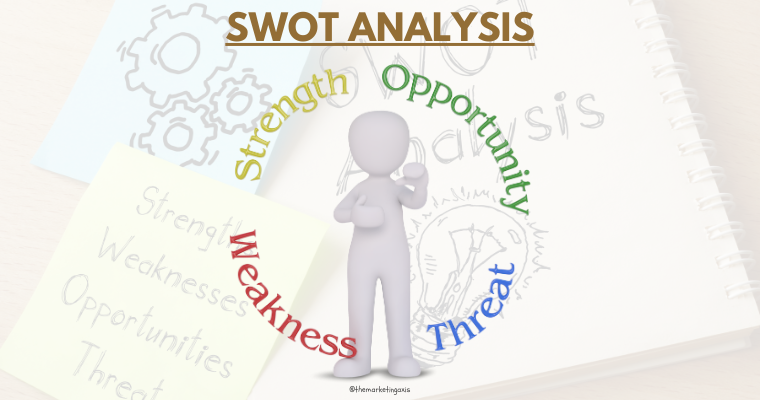SWOT analysis is a strong tool in strategic planning primarily used to understand the business or individual by identifying and evaluating its strengths, weaknesses, opportunities, and threats. It helps comprehend the internal and external factors that influence an organization or personal goals to success. This article contains the elements of SWOT analysis, the template, how to do a SWOT analysis, major company examples like Apple, Amazon, Nike, and Walmart, and personal SWOT analysis in this article. We will also talk about its benefits. contains the elements of SWOT analysis, the template, how to do a SWOT analysis, major company examples like Apple, Amazon, Nike, and Walmart, and personal SWOT analysis
What is SWOT Analysis?
SWOT analysis is a framework designed to assess the associated internal and external factors within an organization or individual. This means:
Strengths: these are the positive internal attributes.
Weaknesses: The internal attributes that hurt the realization of the objective.
Opportunities: These are those factors external to the entity that it can better ground from or use to its advantage.
Threats: Factors beyond the control of the entity or project that may cause trouble.
SWOT Analysis Template
Here is a simple SWOT analysis template:

How to Do a SWOT Analysis
- The following is the process to carry out a SWOT analysis:
- Identify Objectives: The objective behind the SWOT analysis needs to be determined. The objectives can either be general or specific.
- Gather Information: Information on internal and external factors is collected.
- List Strengths: Internal strengths are identified and listed down.
- List Weaknesses: Internal weaknesses are identified and listed.
- Identify Opportunities: Opportunity external to an organization is identified and listed.
- Identify Threats: Threats external to that organization are identified and listed.
- Analyzing and Planning: Finally, on gathering information on all of the four factors, the information is analyzed and strategies are developed in order to use the strengths and opportunities to design and implement effective plans to improve the weaknesses and decrease threats.
What Are the Four Parts of a SWOT Analysis?

Strength: These are the internal attributes and resources that can help you achieve a successful outcome—things like a powerful brand, loyal customer base, strong financials, and proprietary technology.
Weaknesses: These are internal attributes and resources which act against or hinder a successful outcome. This may include cases of a weak brand, declining market share, poor reputation, and high levels of debt.
Opportunities: These are the factors that can be exploited to advantage by the entity within the environment, such as a growing market, developments in technology, and favorable regulatory conditions.
Threats: These include those factors external to it that may potentially pose a threat to its success. They range from an economic downturn to increasing competition and, finally, to regulatory policy changes.
Personal SWOT Analysis
A personal SWOT analysis helps to know their strengths, weaknesses, opportunities, and threats. It becomes a very handy tool for personal development and planning one’s career. This is how a personal SWOT analysis is done:

- Strengths: Identify your skills, talent, and achievements candidly.
- Weaknesses: Areas where you would like to improve upon.
- Opportunities: Look out for opportunities and better prospects.
- Threats: Beyond the control that may cause trouble.
Company SWOT Analysis Examples
Apple SWOT Analysis
- Strengths:
- Good brand reputation and brand-loyal customers.
- High-profit margins and stability in finances.
- Innovative and advanced products with leading-edge technology.
- Weaknesses:
- The high prices of products as compared to competitors.
- Over-reliance on the sales of iPhones.
- Lower market shares in developing markets because of competition from local brands at cheaper rates.
- Opportunities:
- Market expansion.
- Rise of services like Apple Music and Apple TV+.
- Artificial Intelligence and Augmented Reality Growth.
- Threats:
- High competition from other technology companies.
- Trade tensions and regulatory scrutiny.
- The speed at which technological changes are taking place.
Amazon SWOT Analysis
- Strengths:
- Great brand and large customer base.
- Diversified array of products; in almost every country across the world.
- Leader in cloud computing through AWS (Johnson et al., 2008).
- Weaknesses:
- Low profit margins for retail
- Having a dependency on third-party sellers.
- Labor malpractice criticism (Bodie et al., 2014).
- Opportunities:
- Entering new markets.
- Artificial intelligence and machine learning growth.
- Increased demand for cloud services (Malkiel, 2003).
- Threats:
- Regulatory action, antitrust issues.
- Rivals in e-commerce and technology.
- Cybersecurity risks (Johnson et al., 2008).
Nike SWOT Analysis
Strengths:
- International presence with a strong brand
- Product innovation, a technological, effective marketing strategy, and endorsement.
Weaknesses:
- Dependence on third-party manufacturers
- HIGH PRODUCT PRICING
- LABOUR PRACTICE SCANDAL.
Opportunities:
- Fast-growing emerging markets
- Growth of the digital and e-commerce channel
- The demand for Athleisure and sustainable products.
Threats:
- High rivalry from other sportswear brands
- Economic slowdown209 – impact on consumer spending
- Fluctuation in currency rates Johnson et al. 2008
Walmart SWOT Analysis
Strengths:
- A vast network of distributions and presence worldwide.
- Powerful brand name and a large number of customers.
- Reasonable pricing strategy compared to its competitors 2.
Weaknesses:
- Scanty profit margins.
- Dependency on the home market of the US.
- Adverse publicity about its labor policy 1.
Opportunities:
- Emerging markets expansion.
- E-commerce and online grocery growth.
- Higher demand for private label products 3.
Threats:
- Tough competition from other giant retail stores.
- Economic slowdowns that may hurt consumer consumption.
- Changes in regulatory policies 2.
Conclusion
SWOT analysis is one of the important tools in strategic planning. It helps businesses and individuals to take a closer view of their strengths, weaknesses, opportunities, and threats. Here with all these factors can make informed decisions on the formulation of effective strategies for growth and success. Starting from the analysis of technological giants like Apple and Walmart, the retail giant, and down to personal SWOT analysis, this framework comes out very resourceful with valuable insight and guidance.
Also Read: Slept Analysis
FAQs
- What is SWOT analysis?
SWOT analysis is one of the major strategic tools available that allow for the identification and evaluation of the Business or individual’s Strengths, Weaknesses, Opportunities, and Threats 2.
- How does SWOT analysis benefit businesses?
SWOT analysis is one of the techniques businesses use to help in the identification of different factors, both internal and external, affecting their success or failure; it enables informed strategic decisions to be made 1.
- Can you provide an example of a SWOT analysis?
Yes, examples include the strength of Apple innovating, high pricing as a weakness, expansion opportunities for Amazon, and competitive threats for Nike 3.
- How do you conduct a SWOT analysis?
SWOT analysis involves the objectives, gathering information, listing down the strengths and weaknesses, identifying the opportunities and threats, analyzing the data, and developing a plan 2.
- Why is SWOT analysis important for strategic planning?
SWOT analysis is important for strategic planning since it provides that disciplined process of reviewing major factors to success and helps develop the strategies needed to achieve the goals of that plan 1.
References
- Bodie, Z., Kane, A., & Marcus, A. J. (2014). Essentials of Investments. McGraw-Hill Education.
- Johnson, G., Scholes, K., & Whittington, R. (2008). Exploring Corporate Strategy: Text and Cases. Pearson Education.
- Malkiel, B. G. (2003). A Random Walk Down Wall Street: The Time-Tested Strategy for Successful Investing. W. W. Norton & Company.






6 Comments